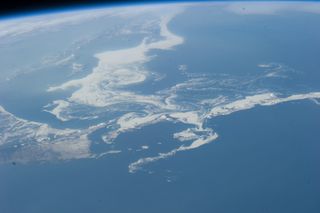Icy Ocean Current Seen from Space (Photo)

Swirls of sea ice mark major ocean currents near Japan in a new photograph taken from space.
The new space picture shows the Sea of Okhotsk in the upper right, and the Japanese island of Hokkaido in the lower left. Between the two is a brilliant line of sea ice heading south. The Kuril Islands are also visible off the coast of Hokkaido.
The ice is entrapped in the East Sakhalin Current, according to NASA's Earth Observatory. Up north, by Russia's Sakhalin Island, the ice clings to the coast; as it moves south, it gets caught in eddies, creating the swirling, spiraled patterns seen by Hokkaido.
This astronaut photo was taken from the International Space Station on April 14. It's not the first time NASA has turned ocean currents into Earth science art. In 2012, the space agency released a dreamy video of ocean currents across the globe over two-and-a-half years. The animation, based on a computer simulation of ocean currents, shows major currents such as the Gulf Stream along the eastern United States, as well as smaller eddies driven by the Earth's rotation.
Ocean currents affect the melting of ice, the movement of debris and the rate at which the ocean absorbs carbon dioxide.
Follow Stephanie Pappas on Twitter and Google+. Follow us @livescience, Facebook & Google+. Original article on Live Science.
Sign up for the Live Science daily newsletter now
Get the world’s most fascinating discoveries delivered straight to your inbox.

Stephanie Pappas is a contributing writer for Live Science, covering topics ranging from geoscience to archaeology to the human brain and behavior. She was previously a senior writer for Live Science but is now a freelancer based in Denver, Colorado, and regularly contributes to Scientific American and The Monitor, the monthly magazine of the American Psychological Association. Stephanie received a bachelor's degree in psychology from the University of South Carolina and a graduate certificate in science communication from the University of California, Santa Cruz.
Most Popular



